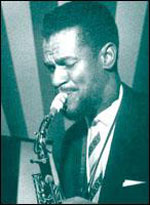
Joe Harriott
So sort of starts Val Wilmer’s Mama Said There’s Be Days Like These, the completely inspiring account of her life in the world of jazz. She was writing in the late ‘80s about a film that came out in the late ‘50s. Even now Bert Stern’s movie seems magical, and footage of the incredibly restrained but simmering intense rendition of 'Blue Sands' by the Chico Hamilton Quintet still captivates me endlessly. But imagine the effect it will have had at the time on a teenage girl in south London suburbia, already besotted with blues and jazz, and irrevocably drawn to the world where the magic’s made.
Against the odds Val Wilmer glided from being a teenage fan to being a chronicler of the music and world she loved. From the late ‘50s onwards she wrote about the black artists who visited London, and over time turned into a photographer blessed by being in the right place at the right time. We now understand just how important it was that Val was around, with her unique insights and a camera to capture what is essentially still a secret history.

Shake Keane
One of the photos used for that Honest Jon’s compilation is of Shake Keane, a trumpet player. Keane is now recognised for the vital contribution he made as a partner to the immensely gifted saxophonist Joe Harriott, whose records made here in the early ‘60s, such as Abstract, rate with the best and most adventurous jazz records ever. But it took an awful long time before any recognition was granted in their adopted homeland though.
Myself, it was not until the late ‘90s that I even got to hear Harriott. And it was only around the same time that I read a reprint of Val Wilmer’s most celebrated work, As Serious As Your Life, her labour of love which documents the fire music, the free jazz made in the US, and which she again was privileged to be part of, and shrewd enough to capture.
I read the book riding on a wave of beautifully-packaged, salvaged sets from Impulse! Not just John Coltrane, but Archie Shepp, Albert Ayler, Pharoah Sanders, Sun Ra, and especially the revelation of Alice Coltrane’s own recordings. As Serious As Your Life provided the perfect literary context for listening to these liberating and challenging recordings. The book delineated the struggles and successes of John Coltrane, Cecil Taylor, Ornette Coleman, Sun Ra, Albert Ayler, and the Art Ensemble of Chicago, the wider cast of participants in the new music, the struggle to get this music heard, and the politics, explicit and implied, that underpinned all the activity. It remains perhaps the most powerful book about music, and will have you desperate to hear for example Sonny and Linda Sharrock performing 'Black Woman'.

The Raincoats
There is an irony that a book as powerful as As Serious As Your Life was missed by my own generation, emerging as it did at the height of the punk explosion. There were, however, pockets of activity at the adventurous fringes of punk where interest in the fire music, free jazz, thrived, and where young women made some incredibly adventurous music which hinted at all sorts of possibilities. And one senses that Val Wilmer must have approved inordinately of the Raincoats claiming to be influenced by “Chic, African music, Abdullah Ibrahim, funk, cajun music, and the ever present reggae along with the continuum of guitar-based post-punk”, while making music that was remarkably brave and fragile.
Whenever Val Wilmer’s incredibly evocative snapshots of a different age appear, it is worth remembering the defiantly bold and passionate soul striking out to do what she had to do. The outsider who took so many unlikely steps, but struggled on and became an integral part of the jazz world she loved so much. The outlaw that stayed a fan for so long.
© 2006 John Carney